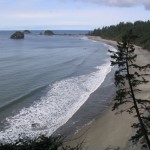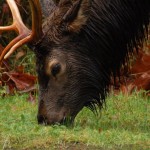WHAT
A hundred shades of green, dappled sunlight on the forest floor, and a hushed silence peacefully interrupted by the soft whisper of water mesmerizes visitors in the Olympic Rain Forest. Mosses, lichens, and ferns appear in astounding numbers. They compete in finding a place to take hold, live out their lives and make their significant contribution to this forest environment. Abundant annual rainfall exceeding 144 inches, and the moderating effect of a steady temperate on-shore flow of Pacific air are the two most critical elements sustaining the Park’s rain forest.
WHERE
The rain forest is not confined to the Park, but also extends northward along the British Columbia coast to southeast Alaska. It is one of only six such forests on the planet. ONP made the decision to develop its educational demonstration of the rain forest at the Hoh River trail head. While the Hoh River is in the rain forest, it makes up only a portion of it; the valleys of the Calawah, Bogachiel, Queets and the Quinault rivers also are part of this distinct and amazing portion of the Park.
WHY
The west side of the Park was passed by during the continental glaciation of the last ice age. As such, it has benefited from thousands of years of soil development brought about by the continual accumulation of organic matter on the forest’s floor. This nutrient-rich resource and the abundance of water is the foundation for both the immense size and number of trees found in the rain forest. Ten World or National record sized trees call ONP home; seven of them are in the rain forest. An eighth, the World’s largest Sitka Spruce,  is just outside the Park boundary, on the south shore of Lake Quinault. Some of these massive trees are over 1000 years old and will continue to survive with a measure of visitor caution.
is just outside the Park boundary, on the south shore of Lake Quinault. Some of these massive trees are over 1000 years old and will continue to survive with a measure of visitor caution.
WHEN
Water-loving plants, including an array of beautiful and delicate forest flowers, are present. Because the rain forest lies at low elevations, spring arrives in March and April, unlike the higher elevation in the Park that must wait to be embraced by the warmth as it ascends the slopes. The growth cycles of plants vary, but they enjoy a very long and vibrant growing season. Oddly enough, the driest part of the year, from the end of August into early September, takes its toll on these plants. The heat, and a lessening of their water sources, often causes them to wither slightly as they attempt to conserve water and survive this brief but challenging annual event.
The heat and drying of late summer also has an effect on the animals. Elk often take refuge on gravel bars in the rivers, gladly accepting the cooling effect of the downstream breezes, and the difficulty that a fresh and constant flow of air present to pesky flies, the bane of many Park animals. Reptiles and slugs seek temporary refuge in dark, damp places and often hide under leaves and forest debris. Some animals, like bears and deer, often solve their heat problem by moving up the valleys to higher, cooler ground. Others, like the river otters, ignore the event altogether and continue their lives unchanged by the season.
The dry period ends with the beginning of the autumn rains. Salmon have been waiting for the increase in a river’s flow-rate off shore. They get one, and only one, chance to return to spawn and they will make certain that enough water is present to increase the chances of their success. The timing required to see salmon moving upstream is difficult to predict beyond the season in which it happens with yearly regularity. Sightings have been reported in Taft Creek, across the road from the Hoh Campground in late September on into October, but the event is difficult to predict with any degree of accuracy. The rain occurs throughout the rest of the year, with small breaks. Snow may fall in the rain forest a few times in the winter, but its stay is very brief, measured in days. The rain forest is temperate, thus accessible all year round, but it is a rain forest so come prepared to get rained on. For more information about the Olympic Rainforest click here.



